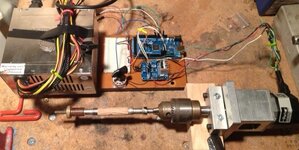There are times I like to spin parts slowly ~50 rpm or less without tying up the lathe. Sometimes its for a finish application, sometimes filling a carving with epoxy and sometimes just for fun.
Started tinkering with an Arduino, added a few leftover CNC parts and a stepper motor and soon I had what I was looking for.
Any other pen turning Arduino applications out there?

Started tinkering with an Arduino, added a few leftover CNC parts and a stepper motor and soon I had what I was looking for.
Any other pen turning Arduino applications out there?

